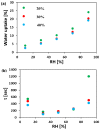Electrospun Anion-Conducting Ionomer Fibers-Effect of Humidity on Final Properties
- PMID: 32369925
- PMCID: PMC7284427
- DOI: 10.3390/polym12051020
Electrospun Anion-Conducting Ionomer Fibers-Effect of Humidity on Final Properties
Abstract
Anion-conducting ionomer-based nanofibers mats are prepared by electrospinning (ES) technique. Depending on the relative humidity (RH) during the ES process (RHES), ionomer nanofibers with different morphologies are obtained. The effect of relative humidity on the ionomer nanofibers morphology, ionic conductivity, and water uptake (WU) is studied. A branching effect in the ES fibers found to occur mostly at RHES < 30% is discussed. The anion conductivity and WU of the ionomer electrospun mats prepared at the lowest RHES are found to be higher than in those prepared at higher RHES. This effect can be ascribed to the large diameter of the ionomer fibers, which have a higher WU. Understanding the effect of RH during the ES process on ionomer-based fibers' properties is critical for the preparation of electrospun fiber mats for specific applications, such as electrochemical devices.
Keywords: electrospinning; fibrous morphology; ionomer; polymer fibers; relative humidity.
Conflict of interest statement
The authors declare no conflict of interest.
Figures






References
-
- Chronakis I.S. Novel nanocomposites and nanoceramics based on polymer nanofibers using electrospinning process—A review. J. Mater. Process. Technol. 2005;167:283–293. doi: 10.1016/j.jmatprotec.2005.06.053. - DOI
-
- Halperin V., Shter G.E., Beilin V., Grader G.S. Mesoporous K/Fe–Al–O nanofibers by electrospinning of solution precursors. J. Mater. Res. 2015;30:3142–3150. doi: 10.1557/jmr.2015.296. - DOI
-
- Shmueli Y., Shter G.E., Assad O., Haick H., Sonntag P., Ricoux P., Grader G.S. Structural and electrical properties of single Ga/ZnO nanofibers synthesized by electrospinning. J. Mater. Res. 2012;27:1672–1679. doi: 10.1557/jmr.2012.118. - DOI
-
- Elishav O., Beilin V., Shter G.E., Dinner O., Halperin V., Grader G.S. Formation of Core-Shell Mesoporous Ceramic Fibers. J. Am. Ceram. Soc. 2017;100:3370–3374. doi: 10.1111/jace.15022. - DOI
Grants and funding
LinkOut - more resources
Full Text Sources

